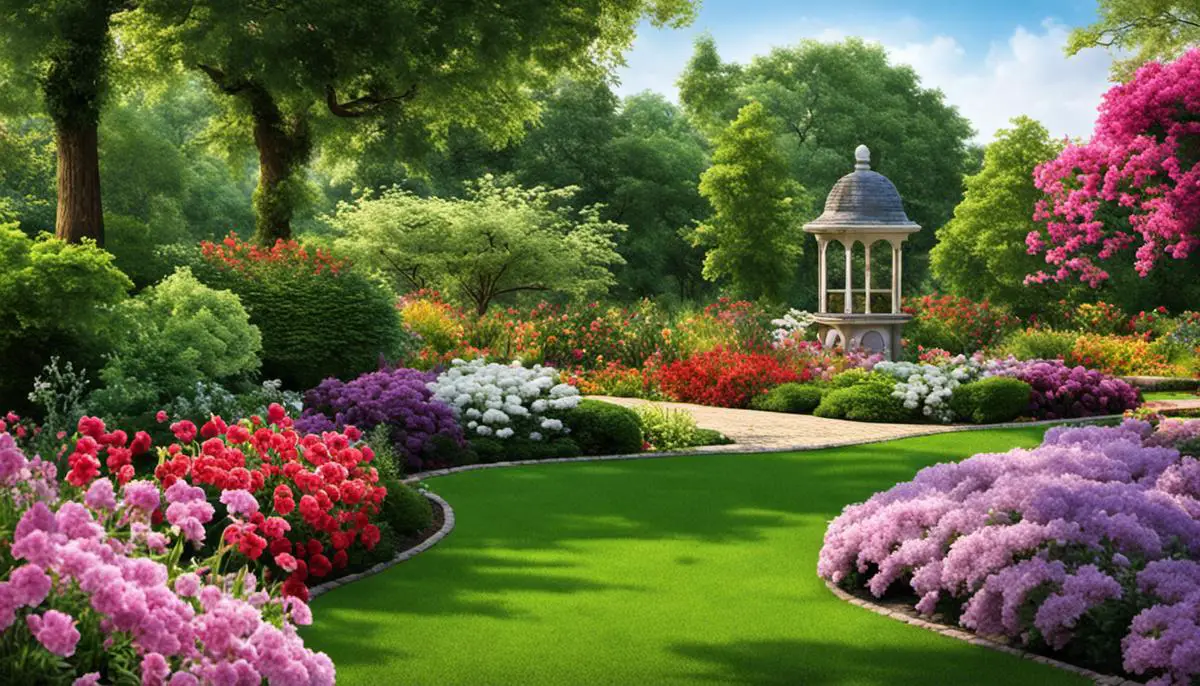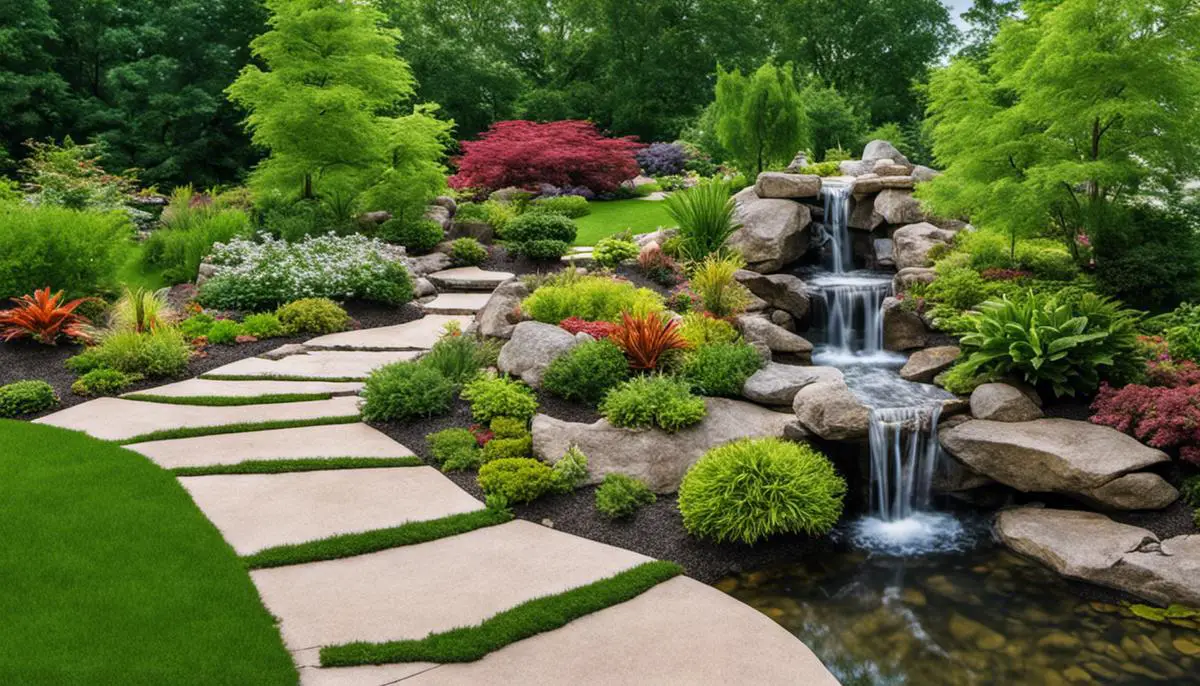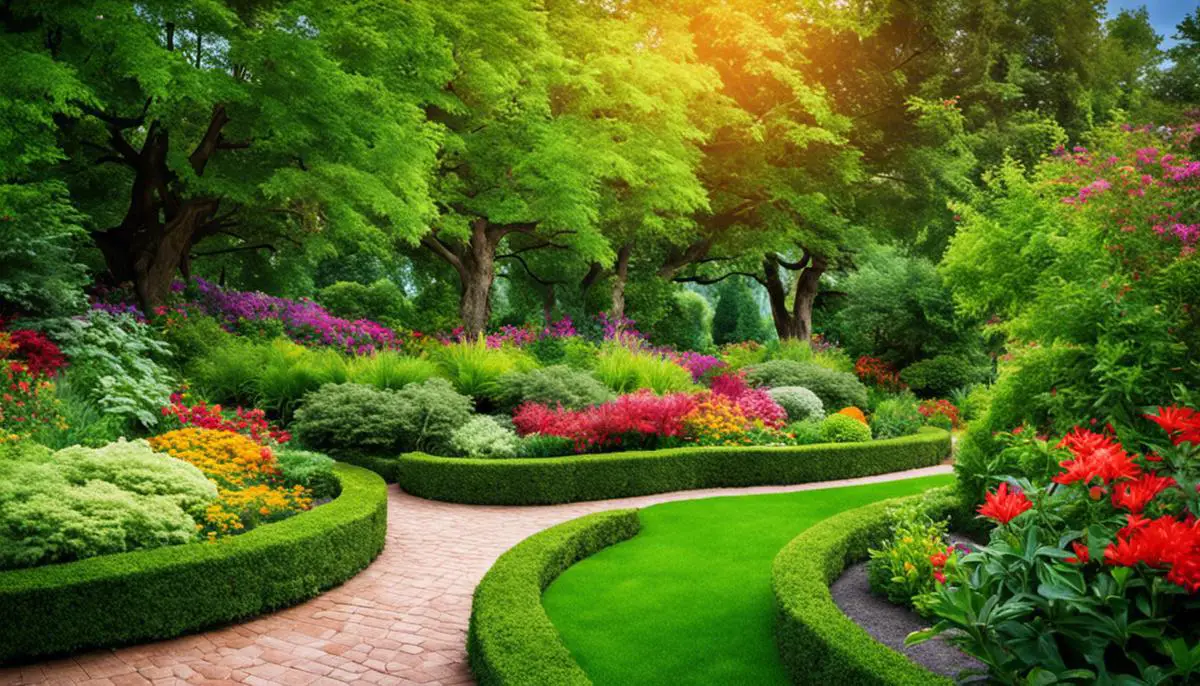Uncover Creative Landscape Ideas for Your Garden
Whether you’re an aspiring green thumb or simply enjoy the tranquility a beautifully landscaped garden can provide, understanding the art and science behind garden landscaping is a journey worth embarking on. From the esoteric terminologies to the intricate processes involved in creating your own oasis, it’s an enlightening process that rewards patience, creativity, and attention to detail. This piece explores the heart and soul of garden landscaping, delving into core concepts, guiding principles, and innovative ideas that define this art. It guides you through the journey, offering valuable insights on popular garden styles, choosing the right elements for your landscape, and maintaining your lush, vibrant garden over time.
Understanding the Basics of Garden Landscaping
Understanding Garden Landscaping Terminologies
Delving into the art of landscaping, a garden demands understanding of various terminologies. One such term is ‘hardscape’, which refers to the hard, non-living parts of the landscape such as patios, walls, and walkways. The opposite of hardscape is ‘softscape’, which encompasses the living parts of the landscape: trees, plants, and flowers. ‘Xeriscaping’ is a method that uses low-water plants and soil improvements to restrict water use, ideal for drought-prone areas. ‘Sustainability’ refers to the use of organic and environmentally friendly techniques to maintain the garden.
Significance of Site Analysis
Site analysis is an integral part of garden landscaping. It involves a detailed inspection and evaluation of the current condition and features of the site, including the type of soil, climate, topography, and existing vegetation and buildings. This helps in understanding what designs and plants will work best for that particular site. Without proper site analysis, landscaping efforts may face problems such as water logging, poor plant growth, and inappropriate design fit.
Guiding Principles: Balance and Proportion
Balance and proportion are vital guiding principles in garden landscaping. Balance refers to the equal distribution of visual weight in a landscape. It can be symmetrical (mirroring elements on both sides) or asymmetrical (using different elements to achieve equilibrium). Proportion, on the other hand, means the size of parts in relation to each other and to the landscape as a whole. It’s important to make sure that the size and layout of your garden components do not overshadow one another or the landscape itself.
Role of Focal Points in Garden Landscaping
Focal points in garden landscaping direct and draw the viewers’ attention. They could be a striking tree, a colorful flower bed, a garden ornament, a fountain, or even a stunning view. The central idea is to create an eye-catching feature that will stand out and create visual interest. Focal points can also be used to distract from unsightly features like a compost pile or utility box.
Process of Designing a Garden Landscape
The process of designing a garden landscape from scratch involves several steps, starting with a site analysis, followed by brainstorming ideas and sketching out designs. Next, the garden layout, including the placement of hardscape elements, is decided. Then, suitable plants that fit the site’s conditions and meet the design’s requirements are selected.
Climate, soil type, and sun exposure will all dictate plant selection. Irises, ferns, and hostas thrive in shady spots, while lavender, butterfly bush, and sunflower need sun. The color scheme and plant combinations are also vital considerations. After planting, regular watering, nutritious soil, and attention to each plant’s specific needs regarding sun, water, and temperature are necessary to maintain a beautiful, thriving garden landscape.
Finishing Touches for a Garden Landscape
Once the plants are settled in, adding accessories such as lighting, water features or garden art can enhance the garden’s beauty. Outdoor lights can highlight focal points and create dramatic effects at night. Fountains, ponds or birdbaths provide a serene ambiance with the soothing sound of flowing water. Garden art, birdhouses or sculptures can lend a personal touch to your garden, reflecting your style and personality.
Regular maintenance like pruning, deadheading, and applying organic compost or fertilizers will keep your garden landscape looking its best. Monitoring for pests and diseases and taking immediate action can save your plants from potential damage.
Embarking on the journey of garden landscaping is an adventure in creativity. It’s an opportunity to test your ideas, acquire new skills, and most importantly, enjoy the process. The potential for change and growth in your garden landscape is limitless.

Innovative Landscape Ideas and Popular Styles
Exploring Creative Landscape Ideas
The realm of landscape design extends beyond conventional floral gardens, introducing an array of innovative ideas that can infuse your outdoor space with a unique artistic flair. One imaginative concept includes floating gardens where plants thrive on water bodies or rafts, introducing a stunning visual feature to any watery environment. Additionally, for those residing within the urban jungle, green roofs and vertical gardens provide a harmonious blend of nature and architecture. This idea involves cultivating plants on rooftops or growing them vertically on wall surfaces, stairs, or fences. This not only helps regulate home temperatures but also beautifully incorporates natural elements into unexpected areas.
Edible Landscapes and Rain Gardens
Taking the innovative landscape ideas a notch higher, edible landscapes are increasingly becoming popular. This idea intertwines aesthetics with functionality, where flowers, vegetables, and fruits are combined creatively to form an appealing yet edible garden. You can consider this for your garden if you fancy fresh produce right off your compound. Rain gardens are also a spectacular landscape idea that makes use of the natural landscape to create a beautiful low point for rainwater to collect and form an attractive, vibrant aquatic habitat.
Formal and Informal Landscape Styles
Formal gardens are highly organized and have symmetrical patterns. An example of this is the classic “Parterre” design, combining carefully shaped plants and trees with paths and low hedges in often symmetrical arrangements. They showcase a sense of elegance and class, and typically require regular maintenance. In contrast, informal landscapes are often designed with an assortment of flowering plants and ornamental grasses. They encapsulate the feeling of freedom and flexibility, often using curved lines for paths and planting beds.
Woodland and Japanese Landscape Styles
Woodland landscapes are fitting for larger outdoor spaces or gardens with an abundance of native trees. They create natural pathways, winding through trees and shrubs, emulating the tranquility of a forest. Alternatively, Japanese landscape styles are marked by minimalism and simplicity, capturing the essence of nature. This style includes principles like asymmetry, enclosure, and balance. It often incorporates elements like water features, bridges, and stone lanterns.
Mediterranean Landscape Styles
Mediterranean landscape style takes inspiration from the coastal regions of southern Italy, Greece, Morocco and Spain. It emphasizes on the use of warm colors, rustic materials, and drought-tolerant plants. This style situates well with warm-climate gardens, often incorporating vine-covered trellises, courtyards, and water fountains for a calming effect.
The Art of Landscaping
Landscape styles and concepts can vary greatly, allowing enthusiasts and hobbyists to truly let their creativity flow. It’s vital to align your landscape style with the overall aesthetic of your home, garden, and local climate while considering your personal taste. Also, the maintenance each style requires cannot be overlooked. Whichever style you decide on, you’ll be able to enjoy an extraordinary blend of design, inventive expression, and inherent beauty.

Choosing the Right Plants and Elements for Your Landscape
Selecting Appropriate Plants for Your Landscape
Picking out the right plants, trees, and shrubs is a make-or-break decision in the world of landscape gardening. The reason for this is because plant life greatly determines the overall aesthetic appeal, functionality, and biodiversity of your garden.
Considering the conditions that different plant species require to survive and flourish is crucial. Factors such as sunlight intensity and duration, the nature and pH of the soil, local weather, and the availability of water all come into play. For instance, succulents and cacti are ideal for arid climates and places with sandy soil and scarce rainfall. Alternatively, plant types like ferns and hostas prefer humid environments, fertile soil, and mapped sunlight.
It’s also necessary to think about the potential size and spread of a plant at maturity when you select it for your garden. A tree that may seem fitting for a particular spot when young could quickly outgrow its space, causing harm to nearby structures or plants. Furthermore, choosing flowering plants and trees that bloom at different times through the year will ensure your garden holds visual interest across seasons.
Integrating Inanimate Elements into Your Green Space
Including inanimate features such as rocks, fountains, patios, or decks in your garden not only adds visual interest but also serves practical purposes in your landscape setting.
Rocks introduce a textural change against the plush foliage and present a low-upkeep alternative for ground covering. They can be creatively used to construct rock gardens or ornamental walkways, or employed to combat soil erosion in certain areas of your garden.
Water elements like ponds, fountains, or cascades foster a serene and tranquil ambiance that can act as the cynosure of your landscape layout.
Outdoor structures like a patio or a gazebo serve as extended living spaces facilitating an inviting environment for recreation and socializing. These can further be adorned with an assortment of potted plants, suspended baskets, or clinging vines to amplify their appeal and harmonize with the surrounding greenery.
Decking can introduce an element of height and stratification to your garden, apt for terrains with pending inclinations. Paved surfaces are versatile and can be fashioned into walkways, relaxation spots, or terraces.
Landscape illumination can accentuate important features post-dusk and enhance the safety of the outdoor spaces. It can be strategically arranged to showcase walkways, bushes, art pieces, or water elements, creating a magical nighttime setting.
Self-reliant structures such as trellises and pergolas are influential features that generate focal points, impart vertical dimension, and act as aids for climbing plants.
Keep in mind, when incorporating inanimate elements, it’s crucial they are in sync with one another, the plant-life of your garden, local weather conditions, and architectural style of your dwelling. This alignment will ensure a well-balanced, alluring garden scape.

Maintaining your Garden Landscape
Maintenance of Flora and Trees
A major contributing factor to a captivating garden landscape is the robust health and vibrancy of its plant life. Adequate watering and nutrition are vital to their growth. The majority of plants and trees require everyday watering, especially during the warmer seasons, ideally during early morning or late evening when temperatures are cooler. Appropriate fertilization is paramount to provide essential nutrients; options like organic compost, bone meal, and seaweed extract serve as effective fertilizers. Routine pruning encourages healthy growth by eliminating old branches, dead wood, or diseased sections.
Seasonal Garden Maintenance
Each season comes with specific maintenance tasks. Spring is a critical time in garden maintenance as it serves as a preparation phase. It is the time to clean up leftover debris from winter, prune trees and shrubs, divide and transplant overcrowded perennials, and start seedlings indoors for summer planting. Fall maintenance involves raking and composting leaves, mulching to prepare beds for winter, and transplanting and dividing perennials. In winter, prune dead wood off trees and wrap delicate plants in protective fabrics to withstand the harsh cold.
Pest and Disease Control in the Garden Landscape
Pests and diseases can greatly undermine the aesthetic appeal of your garden landscape. Managing pests involves a combination of practices. Regular inspection of your garden can help in early pest detection. Once detected, pests can be manually removed or where this is impracticable, a broad spectrum insecticide could be used. Pesticide use should however be a last resort due to their potential impact on the environment and beneficial garden organisms. For diseases, maintain good sanitation by removing diseased plants and using disease-resistant varieties.
Maintaining the Aesthetic Appeal of the Garden Landscape
To maintain the aesthetic appeal of your garden landscape, consider the use of diverse plants that bring color at differing times throughout the year. Annuals, perennials, deciduous and evergreen plants can bring a continuous play of colors and textures. Also, design elements like paths and patios, water features, fire pits, and lighting can add character to your landscape. Consider adding unique structures like pergolas, gazebos, or arbors. These structures not only improve the visual interest but also provide shelter and serving areas for outdoor entertainment. They can also provide support for beautiful climbing plants.
Long-term Garden Landscape Maintenance
Over time, certain aspects of your landscape might need replacement or renovation. For instance, older trees may need to be replaced because of disease or age. Refresh the garden by introducing new plants to replace those that have passed their peak. Regular soil testing is also crucial in maintaining overall garden health. The results of soil tests allow you to correct any imbalances and provide the appropriate fertilizer where necessary.
Maintaining a garden landscape entails regular, proactive involvement in the garden’s health and aesthetics. With the proper care and attention, you will be able to enjoy a beautiful and thriving garden throughout the year.

Landscape gardening expands beyond the mere act of planting. It is the harmonious blend of understanding your chosen environment, selecting the appropriate elements, and caring for those elements as the seasons pass. It encapsulates an ongoing relationship with nature. With each shrub planted, deck built, or rock placed, you’re essentially painting a scene — a culinary masterpiece nurtured by time and loving attention. Weaving a tale of harmony between man-made structures and the sweeping gestures of Mother Nature takes a detailed understanding, but the resulting tranquility is well worth the effort. Through patience, creativity, and knowledgeable execution, your garden can become a sanctuary, a work of art that evolves and flourishes with each passing season. May this guide provide you with the knowledge to embark on that rewarding journey.

